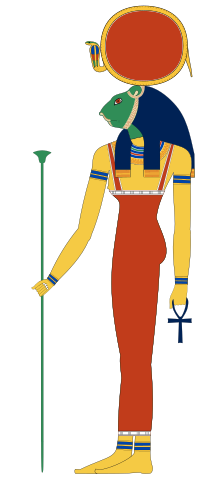Menka ore ooh re or Menka Auuuuraaaaa so they say So open wide
Menkaure
| Menkaure | |
|---|---|
| Menkaura, Mykerinos, Menkheres | |
 | |
| Pharaoh | |
| Reign | 18 to 22 years,[1] starting c. 2530 BC |
| Predecessor | Khafre (most likely) or Bikheris |
| Successor | Shepseskaf |
| Consort | Khamerernebty II, Rekhetre ? |
| Children | Khuenre, Shepseskaf, Khentkaus I ?, Sekhemre |
| Father | Khafre |
| Mother | Khamerernebty I |
| Born | 2532 BC |
| Died | c. 2500 BC |
| Burial | Pyramid of Menkaure |
| Dynasty | Fourth Dynasty |
Menkaure or Menkaura (Egyptian transliteration: mn-kꜣw-rꜥ) was a pharaoh of the Fourth Dynasty of Egypt during the Old Kingdom. He is well known under his Hellenized names Mykerinos (Ancient Greek: Μυκερῖνος, romanized: Mukerînos by Herodotus), in turn Latinized as Mycerinus, and Menkheres (Μεγχέρης, Menkhérēs by Manetho). According to Manetho, he was the throne successor of king Bikheris, but according to archaeological evidence, he was almost certainly the successor of Khafre. Africanus (from Syncellus) reports as rulers of the fourth dynasty Sôris, Suphis I, Suphis II, Mencherês (=Menkaure), Ratoisês, Bicheris, Sebercherês, and Thamphthis in this order.[2] Menkaure became famous for his tomb, the Pyramid of Menkaure, at Giza and his statue triads, which showed him alongside the goddess Hathor and various regional deities.
Sekhmet
| Sekhmet | |||||
|---|---|---|---|---|---|
 | |||||
| Name in hieroglyphs | |||||
| Major cult center | Memphis, Leontopolis | ||||
| Symbol | Sun disk, red linen, lioness | ||||
| Parents | Ra (Or Self Created In Memphis) | ||||
| Consort | Ptah | ||||
| Offspring | Nefertem, Maahes, Imhotep (later accounts) | ||||
In Egyptian mythology, Sekhmet (/ˈsɛkˌmɛt/[1] or Sachmis /ˈsækmɪs/, from Ancient Egyptian: 𓌂𓐍𓏏𓁐, romanized: Saḫmat[2][3]; Coptic: Ⲥⲁⲭⲙⲓ, romanized: Sakhmi), is a warrior goddess as well as goddess of medicine.
Sekhmet is also a solar deity, sometimes given the epithet 'the eye of Ra'. She is often associated with the goddesses Hathor and Bastet.



Comments
Post a Comment
No Comment